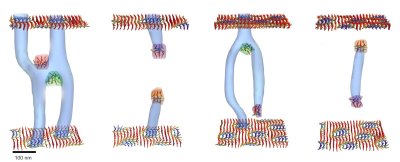Researchers show that skyrmions can move at accelerated speeds using antiferromagnets
An international team of researchers, led by scientists from the CNRS, has reported that the magnetic nanobubbles known as skyrmions can be moved by electrical currents, attaining record speeds up to 900 m/s.
Magnetic skyrmions are topological magnetic textures that hold great promise as nanoscale bits of information in memory and logic devices. While room-temperature ferromagnetic skyrmions and their current-induced manipulation have been demonstrated, their velocity has thus far been limited to about 100 meters per second, which is too slow for computing applications. In addition, their dynamics are perturbed by the skyrmion Hall effect, a motion transverse to the current direction caused by the skyrmion topological charge.
